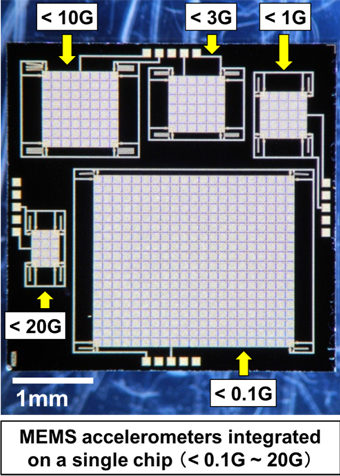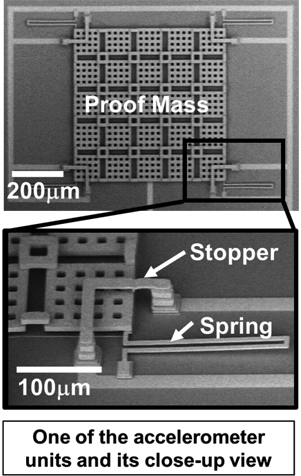Development of High-Resolution MEMS Accelerometer with Capability to Detect Wide Range of Acceleration
Published: December 16, 2014
Professor Kazuya Masu, Assistant Professor Daisuke Yamane, and Professor Katsuyuki Machida, of Tokyo Institute of Technology, succeeded, in a joint project with Professor Hiroshi Toshiyoshi of the University of Tokyo Research Center for Advanced Science and Technology (RCAST) and with NTT Advanced Technology Corporation (NTT-AT), in reducing the size of accelerometer to about a tenth of comparable high-resolution silicon MEMS*1 accelerometer, by using gold in the movable mass. Using this technology and mounting multiple ultra-small, high-resolution MEMS accelerometers on a single chip, the research team opened a path for single-chip measurement of a wide range of gravitational acceleration, from under 1G (G = gravitational acceleration,*2) to 20G. The MEMS structure is designed to allow other devices to be built directly on top of the accelerometer circuits, substantially reducing the areas in the chip occupied by MEMS and accelerometer circuits.
MEMS accelerometers for application in health care, transportation, and infrastructure need to be able to accurately measure a wide range of gravitational acceleration, including sub-G acceleration. The results of this research are particularly useful in health-care sensors for human behavior detection, and will contribute to the development of new devices and systems for medical diagnostics that are based on accurate human behavior analysis and for development of medical robots. The results were presented in November at the international conference IEEE SENSORS 2014, in Valencia, Spain.

Figure 1 : Chip view.

Figure 2 : Scanning electron microscope images.
Explanations of Technical Terms
1.Microelectromechanical Systems (MEMS)
A generic term for three-dimensional micron-scale electronic and mechanical devices that are fabricated using semiconductor microfabrication technologies. At present, the majority of civilian accelerometers are manufactured using silicon MEMS elements.
2.Gravitational acceleration
Acceleration is the rate at which the velocity of an object changes over time. Gravitational acceleration (unit: G) is obtained by dividing velocity (distance/time) by time. 1G is equivalent to 9.8m/s2.
. Any information published on this site will be valid in relation to Science Tokyo.




